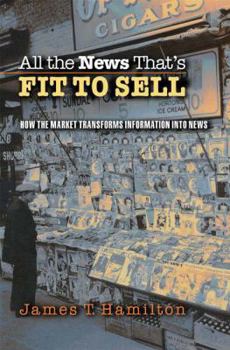All the News That's Fit to Sell: How the Market Transforms Information Into News
Select Format
Select Condition 
Book Overview
That market forces drive the news is not news. Whether a story appears in print, on television, or on the Internet depends on who is interested, its value to advertisers, the costs of assembling the details, and competitors' products. But in All the News That's Fit to Sell, economist James Hamilton shows just how this happens. Furthermore, many complaints about journalism--media bias, soft news, and pundits as celebrities--arise from the...
Format:Paperback
Language:English
ISBN:0691123675
ISBN13:9780691123677
Release Date:April 2006
Publisher:Princeton University Press
Length:352 Pages
Weight:1.20 lbs.
Dimensions:0.8" x 6.8" x 9.1"
Customer Reviews
2 ratings
All the News That's Fit to Sell: How Markets Transform Information into News
Published by Thriftbooks.com User , 14 years ago
For all those searching for the new business model to support ambitious public affairs journalism as newspapers, this book sets out in stark terms the challenges they face. This book should be required reading.
An economist's view of news and its (dis)contents
Published by Thriftbooks.com User , 18 years ago
Having last studied economics as an undergraduate many years ago, I was partially prepared to understand the perspective from which Prof. Hamilton analyzes news, its content, and the market forces dictating that content and its distribution in "All the News That's Fit to Sell". As a citizen concerned with the body politic and its seeming habit of voting against its own long-term economic interests, I was more than curious to understand how, in an age when access to information is almost limitless, people continue to subscribe to political falsehoods and half-truths propagated by our elected officials. Hamilton throws us into the deep end of economic theory right away by observing that "news is a commodity... a product shaped by forces of supply and demand," and thus amenable to market theory to "predict the content of news and evaluate its impact on society." In this way, he wants to show "how consumers' desires drive news coverage and how this conflicts with ideals of what the news ought to be." First, Hamilton places news within the larger category of information goods--goods characterized by being public and experience goods, by product dimension differentiation, and by high fixed costs/low variable costs. These characteristics help explain how market forces determine what becomes news. At the consumer end, Hamilton borrows from Anthony Downs to identify four information demands, i.e. reasons people desire information: consumption, production, entertainment, and voting. For the first three demands, consumption of the news realizes its benefit. For voting, however, the economic cost of investing the time and effort to inform oneself on each of the candidates and their positions does not justify the probability that that individual's vote will change the final election outcome, leading to Downs's conclusion "that voters do not demand information on policy details and choose to remain 'rationally ignorant'." Although recent percentage voter turnout and the public's relative lack of political awareness seemingly bears out Downs's dismal analysis, enough Americans demand political information such that the market provides outlets for "hard news". In Hamilton's formulation, "hard news" contains high levels of public affairs information while "soft news" contains very little or none. This sets up the main thrust of the book: how we can use economics to model media content and predict market failures, i.e. those types of news coverage likely to be underproduced, and what are the ultimate costs of these failures. This assumes, of course, that one can place a standard of value on outcomes of news coverage and consumption. This element of subjectivity "means that economics yields partial, not final, answers in questions about news coverage." But, "If one is willing to make assumptions about media effects and stipulate particular ends for media policy,... then economics can provide more help in the design of policies chosen to achieve a given




